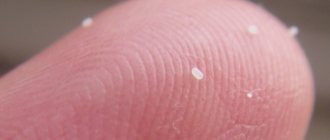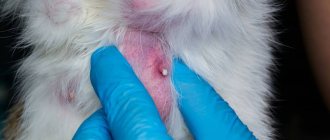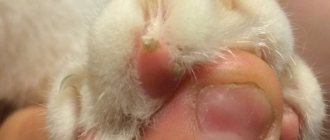The presence of parasites in an animal’s body is a pressing problem for domestic cats. The fact whether the pet is walked on the street or lives exclusively in the apartment is not significant.
An animal can become infected by eating raw meat or poorly cooked fish, licking scraps from a trash can, or simply lying among street shoes. White worms in cats are often found even in healthy-looking animals. When faced with a problem, the owner must treat the pet and take preventive measures.
What to do if your cat has white worms?
Worms enter the animal’s body through the digestive tract, which is where their spread begins. By sticking to the walls of the mucous membrane, worms cause local irritation, erosion, and minor hemorrhages. Feeding on the host's blood, the parasites take away some of the nutrients. Toxins released during the life of worms poison the body.
Larvae or worms can be seen in the cat's feces and on the fur around the anus. Sometimes the worm hangs directly from the anus.
The animal must be shown to a veterinarian. A stool test for worms may not be informative. Therefore, a specialist does not always prescribe such a study. Determining the type of worms is important when choosing treatment.
The pathogen is determined based on the clinical picture and etiology (when the doctor, based on the stories of the pet owner, determines what events preceded the infection, which will indicate to him the source of infection and the type of pathogen).
What type of worms are these?
- round (nematodes);
- tape (cystodes);
- flat (flukes or digenetic flukes).
Why is it important to determine the type of pathogen? Because one drug may be effective against only one class of worms and not affect others.
The presence of white worms in an animal’s feces indicates one of the two most common diseases of parasitic origin:
- In the first case, the causative agent is Toxocara, a type of cat roundworm.
- In the second - dipylidium or cucumber tapeworm.
Toxocariasis
Feline toxocara most often affects kittens under three months of age. In adult animals, the worm larvae become encapsulated and do not develop until sexual maturity. The owner may notice thin, long white worms ranging in size from 6 to 10 cm in the kitten’s stool. This type of helminth is a nematode. Externally, the parasite resembles a thread-like formation with a pointed end.
The infection can be transmitted from mother to fetus, in which case the kittens are born already infected. Reservoir hosts (capable of transmitting infection) can be various animals (for example, rodents) and insects, including earthworms and flies. A kitten becomes infected through contaminated objects, after swallowing insects, eating raw meat or rodent carcasses.
In the pet's intestines, worm eggs mature into larvae and migrate to the lungs. From there, they cough up and return with saliva to the gastrointestinal tract, where they transform into adults capable of laying eggs.
Characteristic signs of the disease:
- dull coat;
- weight loss;
- apathy;
- sour eyes;
- bloated stomach;
- coughing;
- temperature increase;
- vomiting, diarrhea mixed with blood.
A severe degree of infestation can cause the death of the animal. The helminthic mass clogs the intestinal lumen, impairs the passage of food, and in the worst case, leads to rupture of the intestinal walls.
Danger of infection for humans
Toxacara cat eggs are ubiquitous in the environment. Their microscopic dimensions (60-90 microns) do not allow them to be visualized without special equipment. They may be present on the animal's fur, getting there during licking.
Young children are especially at risk of infection because they spend a lot of time on the floor, often pick up and lick dirty objects, and play in a dirty sandbox. For adults, the infection awaits on unwashed fruits and vegetables. Toxocara can be carried by ordinary flies that have previously sat on a contaminated surface.
Humans and other mammals are reservoir hosts for Toxocara, in which the worm cannot develop to a sexually mature individual.
However, in the intestines, eggs are able to turn into larvae and migrate through the bloodstream to the lungs, liver, brain, eyes and other organs.
Having reached its habitat, the larva forms a dense capsule around itself, which clogs the blood vessels and disrupts blood circulation in the organ.
In humans, infection is often asymptomatic. The parasite will begin to manifest itself only when the larvae migrate into organs and tissues.
The extent of the disease will depend on the ability of the immune system to resist infection.
Due to an insufficient response, in rare cases, serious neurotic pathologies or diseases of the visual organs may develop, leading to complete blindness.
Toxocara can certainly be called dangerous to humans, but basic hygiene rules, such as washing hands before eating and handling food, greatly reduce the risk of infection.
Dipylidiasis
The disease is caused by a tapeworm, the cucumber tapeworm. In the body of an animal, the parasite reaches a length of 50 cm. Single individuals do not cause much discomfort. However, with a massive accumulation, worms can cause intestinal obstruction and lead to the death of the cat.
The disease is characterized by general symptoms such as bloating, indigestion, emaciation and loss of appetite. Toxins released by the worm can provoke neurotic disorders in the cat. Pets with a severe degree of the disease experience seizures resembling epileptic seizures.
The animal becomes infected mainly from fleas. The worm's segments (individual segments of its body) are released into the environment with the pet's feces. Outwardly, they look like cucumber seeds, reaching 5-6 mm in length.
Small white worms in a cat can stick to the fur from the anus, but most often the owner discovers the parasites by cleaning the litter box after the pet.
Movable white flatworms will be visually detected in the feces.
The segments of the worm are a shell that hides a cluster of eggs. After the wall is destroyed, the eggs come out. They are partially found on the animal's fur, but in this state they are not dangerous.
The flea, being a larva, swallows eggs, from which the parasite develops in the body of the insect to a cysticercoid - an invasive stage (capable of causing infection). The animal, while licking itself, swallows an infected flea. In the cat's body, the parasite develops into an adult, gaining a foothold in the intestines.
Danger of infection for humans
Dipylidiasis is a disease that can affect people. However, in humans, cases of infection are recorded extremely rarely (no more than once a year). The fact is that the parasite is dangerous only at the stage of larvae, which live in the body of a flea, therefore, in order to become infected, a person needs to swallow an infected insect. Under normal conditions this is practically impossible.
A third of identified cases of the disease are found in children under 6 months of age. Infants who are in close contact with animals are indeed capable of accidentally ingesting parasitic insects.
Treating white worms in cats
For the specific treatment of roundworms in kittens, drugs based on mebendazole and albendazole are used. Veterinarians often advise giving a cat the human drug “Vermox” in tablet form at a dose of 20 mg/1 kg of body weight for three days. The medicine is fed on an empty stomach once a day.
The broad-spectrum drug Milbemax . Its main components are Milbemycin oxime and Praziquantel, which are active against most common nematodes and cestodes.
The medicine is available in tablet form in a separate dosage for kittens and adult cats. The dose is calculated based on the proportion of 2 mg Milbemycin oxime and 5 mg Praziquantel per 1 kg of animal weight. The medicine is given once with food.
Dipylidiasis
The disease is treated with drugs based on Praziquantel. Owners should pay special attention to the fight against fleas, since after treatment the animal can become infected again if the insects are not removed.
For the treatment of dipylidia, there are various combination drugs in convenient dosage forms, such as suspensions or drops on the withers. However, veterinarians prefer tablets, since in this form the substances are most effective.
The complex drug Drontal is often prescribed for cucumber tapeworm.
Its action is based on Pyrantel and Praziquantel. The medicine removes round and tapeworms from the body. One tablet is designed for 4 kg of animal weight. The drug is given once with food.
Prevention of re-infection
Helminthiasis is a dangerous disease for any animal. Worms from cats can be transmitted to humans. Compliance with basic hygiene rules will protect against infection, and regular prevention will keep your pet healthy.
Source: https://glisty.su/belyj-glist-u-kota/
Treatment with folk remedies
When resorting to self-treatment with folk remedies, you act at your own peril and risk. It is worth noting that some veterinarians prescribe traditional methods of treatment when it comes to saving an animal whose body may not withstand additional intoxication from anthelmintics.
First, let me tell you that under no circumstances should it be used against worms in cats. This is celandine, extremely toxic to the cat’s body, but it will not harm worms, and in case of an overdose it can lead to death.
In general, all recommendations for treating cats for worms with folk remedies are quite controversial, and they cannot be called completely reliable. Basically, these are analogues of “human” means.
- Pumpkin seeds are the most common remedy, as their inner shell contains the amino acid cucurbitin, which is poisonous to flatworms. Pumpkin seeds are safe for cats and other animals. It is important that the seeds are raw (dried but not roasted). The seeds (for an adult cat, a dose of 5 g) must be peeled from the hard shell (leave the inner film) and crushed well to a powder, thoroughly mixed with lard (pork fat) or refined sunflower oil and force-fed to the animal for 5 days;
- Onion water is the second no less controversial, but relatively safe method against worms. Cut the onion into 4 parts, pour boiling water (250 ml), drink it to the cat in the morning on an empty stomach for a week. However, we warn you that onions are toxic to cats, and such treatment may lead to cat poisoning;
- Many experienced cat owners recommend giving a decoction of fennel or chamomile The cat is unlikely to drink the broth on its own, and then you can either force-feed it or add a little peppermint to the broth;
- A water infusion of tansy is a method that will not harm (but it is not a fact that it will help). Dried flowers should be poured with boiling water (200 ml) and left in a warm place for an hour. The resulting infusion is filtered and force-fed to the cat 2-3 times a day. For an adult, it is enough to inject up to 2.5 cubes (from a syringe without a needle) at one time. After drinking the infusion, the cat should not be fed for an hour. Treatment is carried out within a week;
- Enemas with carrot juice . Heat the juice squeezed from grated carrots to a temperature (38–39°C) and insert it into the anus. Inject no more than 20 ml at a time. After insertion, the tail should be pressed to the anus and the animal should be held in this position for 10–15 minutes. However, there is no data on the effectiveness of this method.
Deworming (sorry, about worms...)
Pregnant animals are prescribed in the last third of pregnancy, lactating animals - 2-3 weeks after birth, only those drugs that have appropriate indications in the instructions (for example, Milbemax), otherwise they can harm the health of the offspring.
It would be correct to drive away worms 10-14 days before mating. If this has not been done, kittens should be wormed no earlier than 21 days after birth.
Unfortunately, infection of kittens with worms can even occur in utero, during childbirth and breastfeeding.
If the animal has a severe helminthic infestation (the kitten was picked up on the street), parasites are visible in the feces, the animal is vomiting worms, then anti-worm medications should be given under the supervision of a doctor, since the simultaneous death of a large number of helminths can cause poisoning of the body and there will be a need for an IV.
Worms in cats. Cat, cat and kittens
Cats can become infected with a variety of intestinal parasites, including those commonly called worms. Infection with worms causes a number of symptoms.
However, sometimes in cats the disease is almost asymptomatic, and the infection can go undetected despite potentially serious health problems.
Some types of worms that parasitize cats can also pose a danger to human health.
What types of worms are most common in cats?
Roundworms (nematodes) are the most common internal parasite in cats. Similar to spaghetti, adult worms reach a length of 8-10 centimeters. Cats can become infected with these parasites in several ways.
Kittens can become infected with worms through the milk of infected mothers, while adult cats can become infected by eating infected rodents or the feces of sick cats. One of the most well-known parasites among roundworms is hookworm.
Hookworms are much smaller in size than other roundworms - less than 2-3 centimeters long. They live mainly in the small intestine. Because these worms feed on the blood of animals, they can cause life-threatening anemia, especially in kittens. Hookworm eggs are found in cat feces.
These then hatch into larvae that can infect other animals and humans by entering the body through skin contact or through contaminated food and water. Note that hookworms are more common in dogs than in cats.
Long and flat, tapeworms reach a length of 10-70 centimeters, and their body consists of numerous segments. Infection causes vomiting and weight loss.
Cats become infected with tapeworms by eating an intermediate host, such as infected fleas or rodents.
In an infected cat, you can often see segments (worm segments) that resemble grains of rice in the fur around the anus.
Unlike intestinal parasites, lungworms parasitize the cat's lungs. Most cats do not show any signs of having lungworms, but some develop a cough.
Snails and slugs are the most common intermediate hosts for this type of parasite, but cats typically become infected after eating infected birds or rodents.
How can a cat become infected with worms?
Although the methods of infection vary, one of the main methods is through eating the feces of infected animals. Cats can also pass worms to their kittens through their milk. A cat can also become infected with worms through raw meat, fish, other animals and humans.
In addition, many cats love to hunt flies, and flies are carriers of worm larvae.
What are the common symptoms of worm infestation?
Symptoms vary depending on the type of parasite and where it is located, but some common clinical signs include:
- Diarrhea;
- Worms that can be seen in the stool, or worm segments near the cat's anus;
- Bloody stool;
- Severely swollen and round belly;
- Weight loss;
- Vomit;
- Constipation;
- Cough;
- Labored breathing.
Which cats are more prone to infestation with worms?
Cats that are often outdoors, as well as those that regularly visit soil where other animals defecate, are more likely to become infected with worms.
Kittens and cats that are not taken to routine veterinary examinations and dewormed are most at risk of developing complications caused by internal parasites.
What should I do if I think my cat has worms?
It is worth taking your cat to a veterinarian who can confirm the presence of worms. The veterinarian can do this based on a stool analysis. Avoid self-diagnosis, as worms are not always visible and can be difficult to identify.
How to treat worms?
Please do not attempt to treat your pet yourself . First, it is important to identify what type of worms your cat has. Some medications are designed to kill tapeworms, but they will not be effective against roundworms.
And, for example, a drug such as Pyrantel is effective against roundworms (especially for ascariasis, hookworm disease), while it is mild, safe and does not cause intoxication, since it only immobilizes and does not kill worms that are excreted alive in the feces, but is useless when infected with tapeworms.
Broad-spectrum drugs (for different types of worms) can be very harmful and toxic. After such drugs, animals may feel unwell, and symptoms of intoxication are often observed:
- lethargy,
- weakness,
- nausea,
- vomit,
- diarrhea.
After diagnosing the type of parasite your pet has, your veterinarian will prescribe the most appropriate course of treatment.
Can I get worms from my cat?
Yes! Large numbers of worm eggs can accumulate in the area where cats defecate. People, especially children, who accidentally ingest such eggs may develop serious health problems. Nematode larvae can penetrate human skin and cause lesions. People can also become infected with tapeworms through infected fleas.
How to prevent a cat from becoming infected with worms?
- Keep your cat indoors or in an apartment and do not let it roam outside to avoid contact with infected cats, rodents, fleas and feces.
- Make sure your home, yard (if you live in a private home) and pets are free of fleas.
- Maintain good personal hygiene and wear gloves when cleaning the cat litter box. It is also important to clean up your cat's stool frequently.
- Ask your veterinarian to recommend a good medication to prevent infestation. Cats need to be dewormed twice a year, even if your pet doesn’t go outside. Deworming should also be done before vaccinations (to avoid complications).
If there are several animals in the house, everyone should be given the deworming drug at the same time. To get rid of worms, you need to give the drug twice with an interval of 10 days.
Life cycle of tapeworms
Almost all cestodes have a rather complex development cycle, involving at least one intermediate host (insects, ticks, other mammals ), and in the body of each of them the larva undergoes significant changes. It is interesting that at the initial stages of development, the larvae of cestodes have almost all the signs of “normal”, free-living worms, but gradually all the “extra” organs atrophy as unnecessary.
It should be noted that direct re-infection is impossible . So, a cat can even eat the entire cucumber tapeworm segment that comes out of it, but infection will not occur. The egg must be swallowed by the flea larva, and only in its body can the parasite develop to an invasive state. In other cases this will not happen. It is for this reason that one individual of the parasite secretes millions of eggs throughout its life, only a few of which can give birth to new worms.
Important! One of the features of cestodes is that often their adult individuals (but not in all cases) are less dangerous for the animal’s body.
But this point of view is based only on the ability of the larvae of some types of parasites to form cysts with scolex in the tissues and internal organs of an intermediate host, which can be not only a mouse, but also a cat itself. In fact, adult parasites can cause very serious health problems in animals. Symptoms include: severe diarrhea or severe constipation, persistent allergic reactions, etc.
The fact is that worms, capable of growing to very “epic” sizes, compete with the body of the final host for nutrients , which is why the cat does not receive many vitamins, minerals, and other essential compounds. In return, the parasite releases a huge amount of metabolic products, many of which are so toxic that they can provoke the development of edema of the brain, lungs, and other internal organs. Cases have been described in which a sick cat gradually developed neurological seizures caused by encephalopathy.
Finally, let’s look at some of the names of parasitic cestodes that veterinarians most often encounter in their practice:
- Dipylidium caninum. The notorious cucumber tapeworm. It is relatively safe for people, although there are known cases of children who accidentally swallowed an infected flea while playing with a cat. In the human body, the worm does not grow to any significant size, does not live long, and is easily destroyed by the simplest praziquantel.
- Echinococcus granulosus . It is more common in dogs, although the possibility of the disease in cats cannot be ruled out.
- Echinococcus multilocularis . Cats and dogs, as well as humans, get sick. All of them can be both definitive and intermediate hosts of the parasite.
- Mesocestoides spp . Small cattle act as an intermediate host. Cats and dogs become ill because they can eat the remains of meat and other tissue left after slaughter.
- Taenia spp. Tenii are dangerous parasites, the presence of which in the intestines has a very serious impact on the health of the sick animal.
What do worms look like in cats - the main characteristics of helminthiasis
Various categories of parasites constantly infect muscles, liver, and bronchi. They can live not only in humans, but also in domestic animals. To understand how dangerous these individuals are, it is worth knowing that these individuals are able to infect all the most important organs.
The pet, as a rule, experiences complete exhaustion of the body, the cat loses the shine of its coat, its appetite decreases, and the animal also begins to lose weight. Often worms begin to come out through feces and vomit, so it’s worth checking them from time to time.
To do this, you need to know what worms look like in cats.
If these problems exist, as well as if phenomena such as diarrhea and constipation are noted, it is worth taking your pet to a veterinary clinic, where appropriate laboratory tests will be carried out.
Main types of cat worms
Parasites of various types can quite successfully parasitize a cat’s body. There are roundworms, that is, nematodes, there are cestoses or tapeworms, and there are also helminths in cats that are characterized as trematodes, that is, flat flukes. Each of these types of parasites is able to infect a specific organ.
This category of parasites is the most common among all types of parasites. The most common “guests” in the body of a domestic cat are roundworms. Recognizing such parasites is quite easy and simple. They look a bit like spaghetti.
Their length is approximately 5 cm and can be even longer. Small kittens, as a rule, become infected with a disease such as ascariasis through the cat's milk.
She herself lets them into her body if she eats rats, unprocessed meat, and also in the process of contact with other infected animals.
Such parasites form a cluster in the intestines, thereby blocking the bile ducts. Parasites seriously damage the mucous membranes of the digestive organs. Worms of this type have a fairly strong toxic effect on the health of the cat. Other nematodes of round worms include the following two types:
- Hookworms.
- Toxascaridae.
The first ones are about 2 mm long, so they are quite easy to identify. These worms feed exclusively on blood. The second type is more noticeable, since these roundworms can reach 5 cm in length.
Helminths of this category, as a rule, parasitize the liver and other organs of the gastrointestinal tract.
It is worth noting that in a cat’s body such helminths can remain in an inactive state for a long time, so they are not easy to identify.
White tapeworms
In fact, these are special cestodes, which are characterized as flat and can reach 70 cm in length. The peculiarity of the worms is that the body of the helminth consists of a large number of segments. Each of them produces numerous larvae.
The infection process is usually carried out in a situation where the animal’s diet consists of raw, unheated fish and meat. In addition, there is a risk of getting an invasion through carriers of a different type - these could be fleas.
These worms parasitize strictly on the intestinal walls, along its entire length. For this reason, the process of identifying the disease can be much easier, since quite often segments emerge from the anus.
Among the main types of parasites in this category, we can note:
- Tapeworms, which can cause diphyllobothriasis. These parasites are quite easy to identify. They are wide in shape, and the length can reach one and a half meters. Such parasites settle exclusively in the intestines;
- This may be a special cucumber tapeworm that causes such a serious disease as destructive dipylidia. Such worms usually reach 30 cm in length and have a slight grayish coloration. Parasites are usually present in the intestines;
- Alveococcus. These are small worms, the length of which is not more than 4 mm, and they parasitize in the intestines.
- Flat flukes.
There is another type of worms that can be found in cats. These are trematodes, which are white thread-like worms. Their peculiarity is the presence of a large number of suckers, with the help of which they attach to the intestines.
Through such fastening, the mucosal membrane can be seriously damaged in a special mechanical way. Parasites are harmful because they have a serious toxic effect on cats.
These parasites are found much less frequently than other categories of helminths, but they are the ones that pose a mortal danger after infection.
The process of infection of an animal occurs after contact with an infected animal, after a cat digs in the soil, when eating freshwater fish, and so on. Such flukes are parasites that can destroy a person’s internal organs and tissues. It can parasitize not just the intestines, but also the lungs, bladder and liver.
Among trematodes there are such categories of helminths as a special pulmonary fluke, which in the process of parasitism cause paragonimiasis.
The length of this individual can reach 1 cm, and similar worms inhabit the lungs of cats, thereby forming numerous cysts and completely destroying lung cells, which then leads to the death of the animal. The second type of trematode is opisthorchis.
They reach approximately 5 mm in length. A similar type of helminth parasitizes the gallbladder and is present in the liver and pancreas.
General symptoms and main signs
Often parasites come out of the animal during the process of defecation, for example, after taking medication. In addition, the presence of helminths can be detected in the kitten's feces or when it vomits. It doesn’t really matter what type of worms the kitten has; the symptoms are usually all the same. The main features include:
- Presence of larvae in feces after taking anthelmintic medication. They can also exit from the anus;
- There are various stool disorders, for example, diarrhea, constipation, and all this can also alternate;
- A kitten may have worms themselves or small amounts of blood in their stool or if they vomit;
- If a kitten has parasites, you can often observe how it rides on its fifth point, the cause of which is severe itching;
- The animal begins to lose weight quickly, its appetite goes away or, on the contrary, it increases greatly;
- The kitten may have developmental delays;
- Hair may begin to fall out, the cat looks exhausted.
If worms are found in the feces of a kitten or an adult cat, you should immediately show the animal to a specialist. The veterinarian will certainly carry out various research methods and examine the presence of particles in the feces. As soon as a specific diagnosis is identified, the most effective treatment for the kitten and adult cats is prescribed.
It is recommended to treat a sick kitten using special anthelmintic drugs. At the same time, it is necessary to ensure that the pet does not vomit, since the roundworms will not be eliminated. The most effective remedies include medications such as:
- Praziquantel,
- Pirantel,
- Drontal,
- Vacation.
Anatomical features
The anatomy of cestodes itself requires a separate description. The body begins to grow from the head, called the scolex. Flat segments growing from it form the body. Since it looks like a long ribbon, in the literature these parasites are often called tapeworms. As we have already indirectly noted, each segment of the body of cestodes is, in fact, a separate autonomous “container” . These worms have neither a digestive tract, nor a cardiovascular system, nor respiratory organs. In fact, the joint contains some muscle tissue (forming the shell of the “container”) and some nerves. They are needed in order, firstly, to receive a signal from the scolex about the moment of separation. Secondly, the nerves give impulses to the muscle tissue, as a result of which the joint can crawl on its own for some time. Of course, he cannot “decide” what to do next: the joint simply crawls until there is enough energy in the muscles.
However, everything is not so primitive. Each segment has an autonomous reproductive system, and it is bisexual (almost all cestodes, with rare exceptions, are hermaphrodites). In young segments, all organs are in their infancy. By the time the segment reaches the worm's body, they are fully mature. The “female” half releases eggs, the male half inseminates them. Soon after this, the segment separates from the parasite’s body and, together with feces (or “under its own power”), leaves the host’s body, exiting into the external environment.
It is believed that in most parasites the segments begin to secrete eggs while still in the intestines, but in practice this does not happen so often. Because of this, cestodiasis cannot always be determined using stool analysis, since there may not be eggs in the feces. Much more often, eggs are released as they exit the host, and therefore experienced veterinarians advise taking scrapings from the skin near the cat’s anus . There are high chances that either the desired parasite eggs or dried fragments of their segments will be found there. You can do this at home using regular tape. Simply stick it to your cat's "back regions" for a while, then carefully remove the adhesive tape. To prevent anything from sticking to it, you need to glue the tape to a small piece of glass (ideally, a special object is used for this).
Worms in cats: signs and treatment
Infection of an animal's body with worms - helminthiasis - is the most common disease of cats. Parasites pose a danger not only to the pet, but also to its owner; they are easily transmitted provided they exist in the same environment.
Helminths enter the animal's body from the outside. They are found everywhere: in water, soil, raw foods and much more.
Even if a pet has never crossed the threshold of an apartment in its life, this does not mean that it is immune from helminthiasis: worm eggs enter the home along with dirt stuck to shoes and dust on clothes.
Symptoms of cat infestation with worms
Signs that a cat has worms can be obvious (eg, chronic diarrhea, indigestion) or less noticeable. Even a caring owner may not notice lethargy, apathy, or decreased appetite right away, but once they notice it, they may attribute it to the cat’s special mood.
Cats suffer from various types of worms, and in order to properly treat, you need to know which parasite is preventing your pet from living.
Roundworms
One of the most common types of parasites that can be transmitted from animal to animal; dangerous to humans. The length of these worms reaches 5-10 meters, they are white or brown, tapering towards the end.
Sometimes worms come out along with the animal’s feces or vomit - this is the easiest way to diagnose their presence. But, of course, it’s better not to let things get to that point.
The presence of roundworms in a pet’s body can be determined by the following signs:
- The cat's belly swells, as if overeating or gaining weight for the winter;
- Appetite increases abnormally;
- The animal often has the urge to vomit;
- Constant diarrhea;
- Apathy, decreased activity.
Nematodes
Unlike roundworms, nematodes cannot be seen with the naked eye, and it is impossible to look for them in secretions. Once in the cat's body, they begin to suck blood, causing the animal to weaken and suffer from anemia.
If you do not notice the symptoms of nematode damage in time, the outcome can be very sad. The mortality rate among kittens from these parasites is much higher than among adults.
The presence of nematodes can be determined by the following symptoms:
- Blood in the animal's stool;
- Pain in the stomach (localization can be recognized by the positions that the cat takes, how it relates to stroking the belly, and so on);
- Chronic diarrhea.
Nematodes are also dangerous for people and can be transmitted to their hosts. The insidiousness of nematodes is that in adult cats a protective mechanism is triggered - they do not show signs of the presence of worms, and they are stored in their body until a “gap” appears in the immune system.
Solitaires
The spread of these parasites is directly related to fleas. If an animal has ever had fleas, then it is at risk. When a cat swallows a flea, it also swallows the tapeworm eggs that the cat carries.
They develop in the pet's body and lay new eggs. You can notice tapeworms on the cat itself (they are very small and white) or on its sleeping place, where dead individuals usually accumulate.
In appearance, they resemble crumbled rice - just as small and white. A cat has tapeworms if:
- She is losing weight and her appetite has increased significantly;
- White granular inclusions appeared in the animal's feces;
- White parasites accumulate under the tail, in the fur around the tail.
Heartworms
These parasites are quite rare in cats; their presence is more common in dogs. But if the animal has a lowered immune system, is sick or suffers complications from previous diseases, heartworms will not miss this opportunity. Cats become infected with them from mosquitoes - through their bite.
It is very difficult to identify this parasite, since there are no visible symptoms of worm infestation, while the cat weakens and may even die. The presence of heartworms is determined by several blood tests. Suspicion is also raised in the presence of heart and lung diseases.











